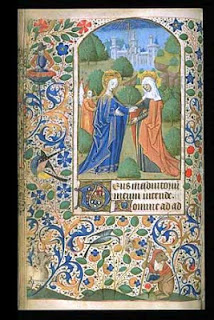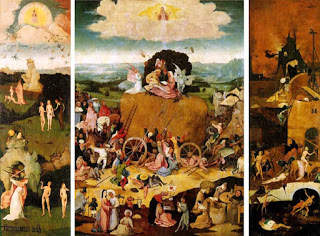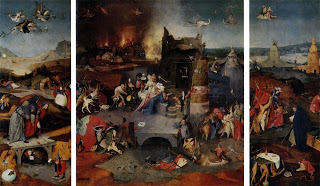Medieval History
My graduate school class had an unusual amount of medieval topics as theses. Each was completely different and absolutely fascinating, so I thought it would be interesting to interview each of my classmates about their theses and thoughts about medieval art.
My first interviewee is Alison Daines, MA. She's a wonderfully insightful scholar whose research interests lie mainly in Netherlandish art and the Northern Renaissance.
 I am fascinated by illuminated manuscripts. Before Gutenberg books were treasures that were handwritten, meticulously copied and passed down. The accompanying images in them are not only beautiful, but full of deep layers of symbolism that corresponds with the written word. As a lover of books, I appreciate that concept.
I am fascinated by illuminated manuscripts. Before Gutenberg books were treasures that were handwritten, meticulously copied and passed down. The accompanying images in them are not only beautiful, but full of deep layers of symbolism that corresponds with the written word. As a lover of books, I appreciate that concept.

- Getty Museum To Explore Representations Of Medieval Architecture
The architectural wonders of soaring cathedrals and majestic palaces are some of the greatest achievements of the Middle Ages and the Renaissance. On view at the J. Paul Getty Museum, in Los Angeles, California, March 2?May 16, 2010, Building the Medieval...
- There And Back Again
There and Back Again: Re-fashioning Journey and Place in the Middle Ages An interdisciplinary symposium at Balliol College, Oxford, 7th June 2008 Confirmed speakers include Colin Morris (Southampton), John Blair (Oxford), John Hines (Cardiff), Kathryn...
- Interviews, Part Iv
My dear friend Rachel was good enough to interview for this blog, and here are her responses! She has an MA in Art History, and wrote her thesis on Jordanian mosaics featuring the Messianic Age motif. She's a fantastic scholar, thorough and well-thought,...
- Interviews, Part Ii
As part of my interviews for this blog, I asked my friend Elliott who is currently working on his doctorate. When it comes to medieval art (or art history in general) I don't think I've met anyone with a greater passion. As you will see, he is...
- New Medieval Art Websites
In this post I would like to call attention to a number websites dedicated to medieval art. I was inspired to do this by the latest post on the blog 1100sor (1100lines) of Gábor Endr?di - a very informative Hungarian blog on Medieval and Renaissance...
Medieval History
Interviews, part I
My graduate school class had an unusual amount of medieval topics as theses. Each was completely different and absolutely fascinating, so I thought it would be interesting to interview each of my classmates about their theses and thoughts about medieval art.
My first interviewee is Alison Daines, MA. She's a wonderfully insightful scholar whose research interests lie mainly in Netherlandish art and the Northern Renaissance.
- What draws you to medieval art?
- What do you wish the general public knew about your area of expertise?
- Do you have any favorite online art or historical resources?
- Your favorite (if you can pick one) artwork from the Middle Ages:

- What area of study in medieval art history do you find the most intriguing?
- In your travels, do you have a specific place (cathedral, city square, museum) that you felt the most 'in touch' with the Middle Ages?
- What was your thesis topic? (I really would like some pictures here!)

I use the underlying theme of Christ's Ascension. Christ's final journey acts as the ultimate goal and the paradigm for both the pilgrim within the triptych and the viewer. Evidence of processional celebrations mimicking pilgrimages reveals that the motifs in Bosch's works were located throughout his visual culture. I also use Bosch's 1505 triptych The Temptation of St. Anthony as an example of Bosch's consistent use of the pilgrimage theme. I argue that he is working within the context of the visual and textual culture of 's-Hertogenbosh, and despite his creative style, was understood among his contemporaries as a messenger of positive piety.

- Getty Museum To Explore Representations Of Medieval Architecture
The architectural wonders of soaring cathedrals and majestic palaces are some of the greatest achievements of the Middle Ages and the Renaissance. On view at the J. Paul Getty Museum, in Los Angeles, California, March 2?May 16, 2010, Building the Medieval...
- There And Back Again
There and Back Again: Re-fashioning Journey and Place in the Middle Ages An interdisciplinary symposium at Balliol College, Oxford, 7th June 2008 Confirmed speakers include Colin Morris (Southampton), John Blair (Oxford), John Hines (Cardiff), Kathryn...
- Interviews, Part Iv
My dear friend Rachel was good enough to interview for this blog, and here are her responses! She has an MA in Art History, and wrote her thesis on Jordanian mosaics featuring the Messianic Age motif. She's a fantastic scholar, thorough and well-thought,...
- Interviews, Part Ii
As part of my interviews for this blog, I asked my friend Elliott who is currently working on his doctorate. When it comes to medieval art (or art history in general) I don't think I've met anyone with a greater passion. As you will see, he is...
- New Medieval Art Websites
In this post I would like to call attention to a number websites dedicated to medieval art. I was inspired to do this by the latest post on the blog 1100sor (1100lines) of Gábor Endr?di - a very informative Hungarian blog on Medieval and Renaissance...
